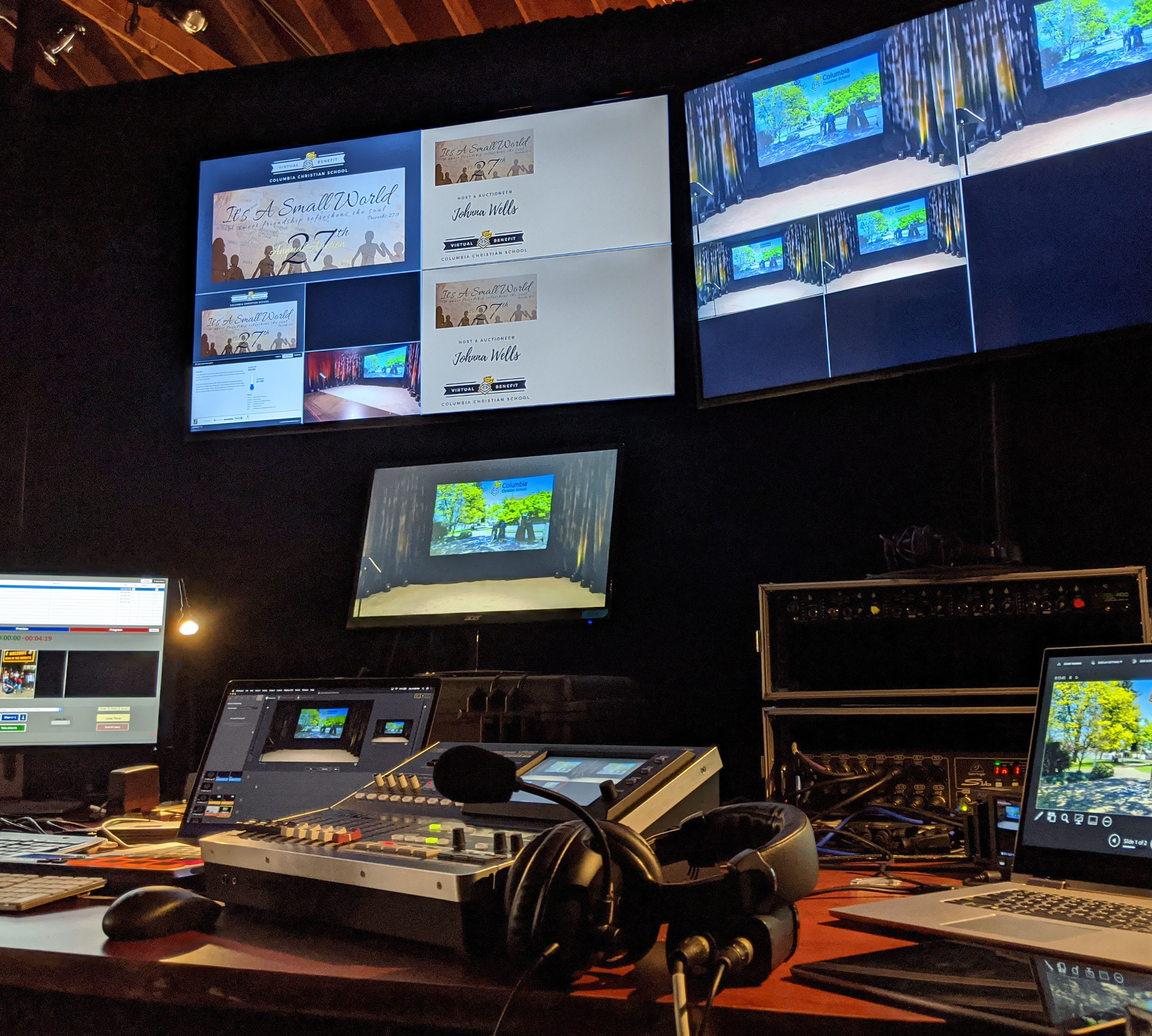By now it’s not news that virtual events are here to stay and while we’re not 100% sure when exactly we’ll be able to gather in person again, we know that once we are able to, expanding the in-person event to include a live webcast to a wider audience is the way of the future in the event industry.
First thing first though, what exactly is a “hybrid event” anyway?
From a previous post we know that a virtual event is any organized event that takes place online rather than in a physical location, and where individuals experience the event and its content in a virtual environment rather than in an in-person gathering. .
On the same token, a hybrid event is any organized event that combines an in-person component with an online or digital experience. With a hybrid event, the scope of the digital component can vary widely and there are no set rule for what a hybrid format could or should be, so you can get creative with what makes the most sense for your event, audience and goals.
Why would anyone want to host a hybrid event in the future?
Now that we got a ‘taste’ of what virtual events can do, planning for a hybrid event once gathering in-person is permissible and safe, is the natural step progression for event professionals who will be faced with some crowd restrictions in the beginning stages of large gatherings. There will also be participants who will be hesitant to travel way past the restrictions being lifted and a hybrid event will enable them as well to attend virtually. But that’s not the only benefit. Hybrid events come with some additional unique advantages, including unlimited scalability, cost effectiveness, increased reach and ROI, valuable data collection and audience insights, and a powerful unified message that can reach people anywhere.
To succeed online, however, you need to captivate your audience. Below are a few prerequisites for a successful hybrid event:
- The video content must be dynamic
There should be a few video cameras with different angles which will allow your online viewer to be as ‘close’ to the content and the experience as they possibly can be. The switching between shots will help keep viewers glued to the screen.
- The program must be interactive
Hybrid events differ substantially from TV viewing because the participants are sitting with their hands next to a keyboard and with a few clicks can be taken away. It is therefore prudent to give some thought on how your online viewers can be drawn in and participate. For example, by asking questions (via chat or Twitter) which will be answered live. Other forms of interactivity are also possible, such as a poll, quiz or a collaborative online brainstorm.
- The event time must be limited
Being a participant in a hybrid event is a special experience where you find yourself watching the same content with all sorts of people from all over the country (or world). ‘Being alone together’. In order to focus that energy and have as many people as possible simultaneously online, a successful livecast needs to take time in consideration and not discount the reasonable attention span than online audience has.
- The presenter must be as entertaining as a talk show
A good livecast is as entertaining as a football game or a modern talk show. There is always a presenter, there are guests, and there is a moderator who directs the online content. These are the simple rules of television, and you’d be extremely remiss if you did not heed all those years of collective experience.
Will hybrid events require more planning and internal resources?
Like any in-person gathering, planning for the virtual component will require careful considerations and planning. One of the main consideration is concerning the format. Knowing the details of your in-person gathering you will have to plan for a concurrent virtual component that is heavily focused towards the online audience that does not have the ability to socialize and interact the same way the in-person audience does. The content and its lengths will have to be carefully planned and considered so it’s engaging and relevant to both your in-person and online participants.
On the same token, live web streaming may make perfect sense for some events but they’re not the only option. Pre-recorded content and semi live event sessions can be just as well used during a hybrid event. The advantage of pre-recorded content is that presenters can be pre-recorded and made available to an online audiences at any time. An example of a semi-live event is when a virtual audience watches pre-recorded content and then the speaker “goes live” for both the in-person and the online audience. With a hybrid event format using a semi live format for the virtual component, the timing and possibilities with online sessions and breakouts are much more flexible.
What is the appropriate number of in-person attendees for a hybrid event?
While COVID-19 remains a threat, every event organizer will need to weigh carefully the pros and cons of meeting in person in the first place, and decide if the rewards of a face-to-face event outweigh the risks. How many in-person attendees to have, is closely linked to the venue and the state you’re gathering in, especially taking in account social distancing and health regulations relevant to your location. If your event is scheduled to take place late fall for example, plan for fewer in-person attendees and more online participants.
How do you market a hybrid event?
To market a hybrid event, utilize the same channels you use to market live events such as social media, content marketing, email marketing, paid advertising, etc. What you might need to plan differently is the timing of your marketing efforts. Based on the data collected from recent virtual events, to maximize your online audience, you’ll want to increase marketing efforts the week before your event takes place, unlike the older trends that planners see marketing for with in-person events.
How can a speaker adapt their content for an online audience?
Public speaking is a skill that you need to practice and learn. The same way, adapting your content and presentation to an online audience with a shorter attention span is a skill that can be practiced and learned. In our three-part series on how to prepare and deliver to a virtual audience we’ve included a handful of tips on how to get ready before a livecast, what to do during the virtual performance, and what to do after the presentation has ended.
Virtual Event Speaker Tips: Preparation (part 1)
Virtual Event Speaker Tips: Performance (part 2)
Virtual Event Speaker Tips: Post-Event (part 3)
How do you keep a virtual audience as engaged as an in-person audience?
To feel included, online attendees want to interact with each other, the presenters, network, participate in games, post on a social wall, etc. They want to do the same things they would do if they travelled to your in-person event. Engagement is more than just answering an audience response poll or participating in Q&A. Those are important but they are just part of the picture, so with a hybrid event, the secret to keeping your entire audience engaged is to make sure that you give them the same engagement tools, whether they are face-to-face or virtual. You’ll also want to host a shorter event, or shorter sessions and provide many networking opportunities for your virtual audience through event apps , your social media hashtag and feed, or birds-of-a-feather networking virtual rooms.
In conclusion, nothing will beat the power of an in-person gathering and everyone knows that. However, a hybrid event will not reduce physical participation. On the contrary! People who can not attend or who have never been heard of, can still pick up the highlight(s) of the event online., and if these highlights are good, it will prompt them to want to travel to the physical venue next time. With a hybrid event you don’t just remove the ‘place’ factor, but also the ‘time’ factor. The livecast can still be viewed (in parts) online later, which expands the long-term reach and also taps into a whole new audience.
The wide reach makes a hybrid event component even more attractive to sponsors. They are not only visible to the in-person participants of your event, but also to online participants. And not only during the event, but also for posterity.
The most important step: experience a hybrid event for yourself!
This is the most important tip we can give regarding hybrid events: make sure you have experienced it as a participant at least once! Only then will you understand how it feels to participate remotely and get a better idea of what the challenges are and where you, the organizer of your next hybrid event, needs to focus your attention.
Let us take the burden off you and your staff so you can focus your attention on your core event activities.
Contact us today to schedule a free consultation and learn more about our virtual event services and see if we could be a great fit for you and your future virtual or hybrid event.



